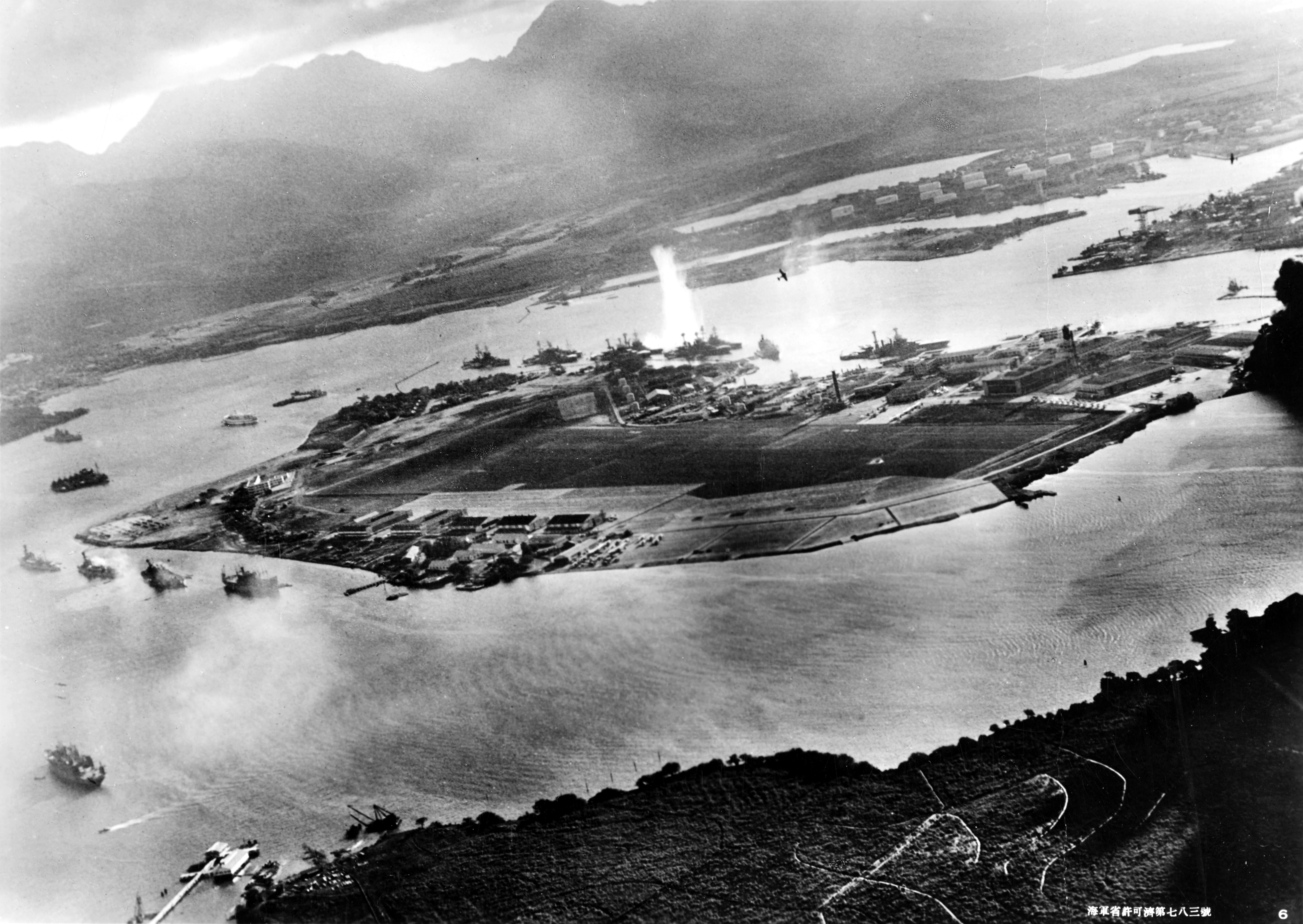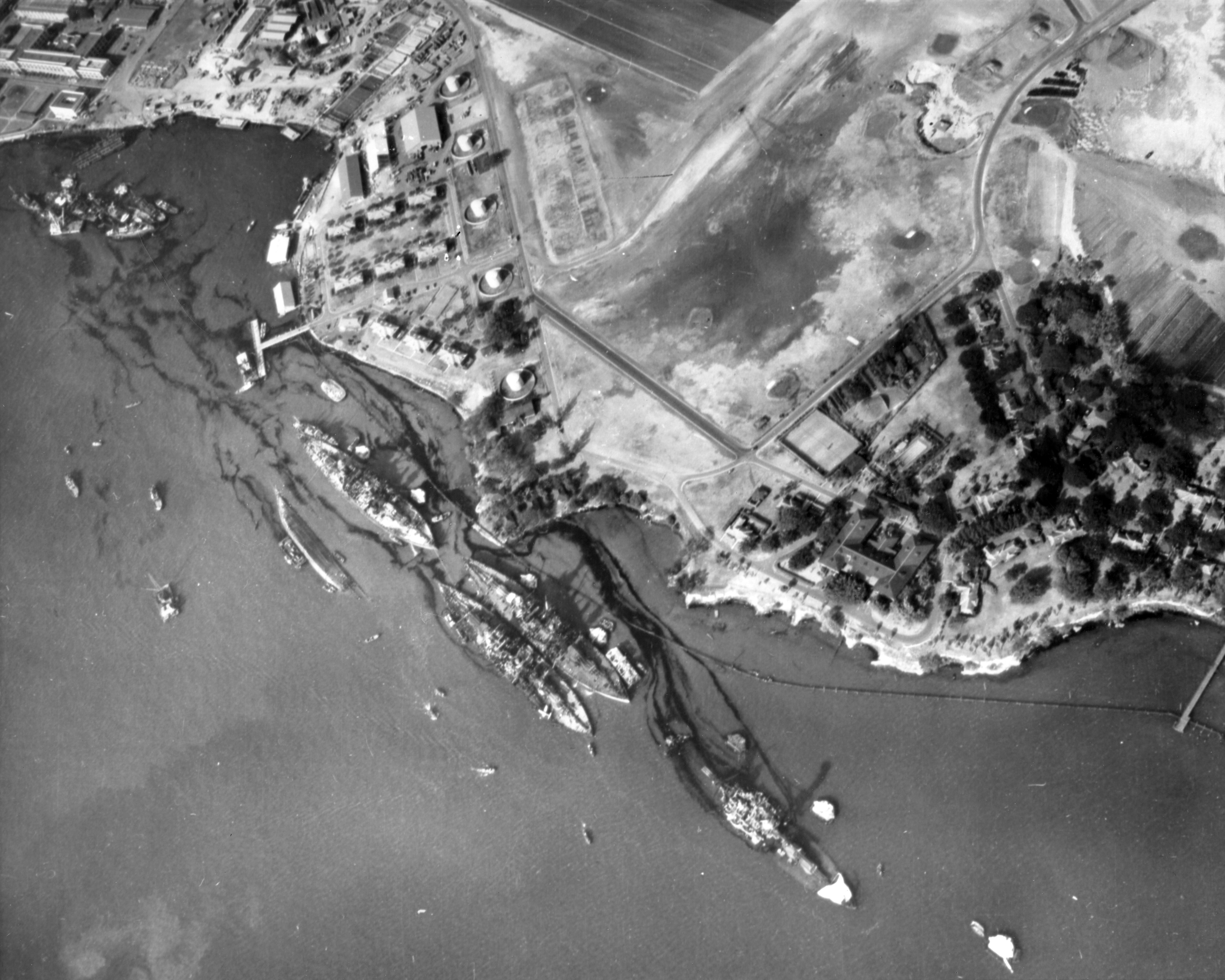Battleship Row on:
[Wikipedia]
[Google]
[Amazon]
 Battleship Row was the grouping of seven U.S.
Battleship Row was the grouping of seven U.S.
 ''Arizona'', ''California'', ''Oklahoma'', and ''West Virginia'' were sunk during the attack (albeit, ''California'' and ''West Virginia'' were refloated and rejoined the fleet in 1944). ''Arizona'' suffered the most serious damage and loss of life, an explosion in a forward
''Arizona'', ''California'', ''Oklahoma'', and ''West Virginia'' were sunk during the attack (albeit, ''California'' and ''West Virginia'' were refloated and rejoined the fleet in 1944). ''Arizona'' suffered the most serious damage and loss of life, an explosion in a forward  was in port at Pearl Harbor, but was not moored with the rest of the battleships, as she had since been converted to a
was in port at Pearl Harbor, but was not moored with the rest of the battleships, as she had since been converted to a
 Battleship Row was the grouping of seven U.S.
Battleship Row was the grouping of seven U.S. battleship
A battleship is a large, heavily naval armour, armored warship with a main battery consisting of large naval gun, guns, designed to serve as a capital ship. From their advent in the late 1880s, battleships were among the largest and most form ...
s in port at Pearl Harbor, Hawaii, when the Japanese
Japanese may refer to:
* Something from or related to Japan, an island country in East Asia
* Japanese language, spoken mainly in Japan
* Japanese people, the ethnic group that identifies with Japan through ancestry or culture
** Japanese diaspor ...
attacked on 7 December 1941. These ships bore the brunt of the Japanese assault. They were moored next to Ford Island
Ford Island () is an islet in the center of Pearl Harbor, Oahu, in the U.S. state of Hawaii. It has been known as Rabbit Island, Marín's Island, and Little Goats Island; its native Hawaiian name is ''Mokuumeume''. The island had an area of ...
when the attack commenced. The ships were , , , , , , and . A repair ship (former coal ship), , was also present, moored next to ''Arizona''.
Creation
When theUnited States Navy
The United States Navy (USN) is the naval warfare, maritime military branch, service branch of the United States Department of Defense. It is the world's most powerful navy with the largest Displacement (ship), displacement, at 4.5 millio ...
decided in 1919 to establish a major naval base in Pearl Harbor, the southeastern side of Ford Island was ceded from control of the Army Air Service
The United States Army Air Service (USAAS)Craven and Cate Vol. 1, p. 9 (also known as the ''"Air Service"'', ''"U.S. Air Service"'' and before its legislative establishment in 1920, the ''"Air Service, United States Army"'') was the aerial warf ...
at the behest of Secretary of War
The secretary of war was a member of the U.S. president's Cabinet, beginning with George Washington's administration. A similar position, called either "Secretary at War" or "Secretary of War", had been appointed to serve the Congress of the ...
Newton D. Baker
Newton Diehl Baker Jr. (December 3, 1871 – December 25, 1937) was an American lawyer, Georgist,Noble, Ransom E. "Henry George and the Progressive Movement." The American Journal of Economics and Sociology, vol. 8, no. 3, 1949, pp. 259–269. w ...
. Due to its location in the center of the harbor, where the water was deepest and the potential for maneuvering greater than along the shores, this coast of Ford Island became the de facto mooring location for the Pacific Fleet's battleships and took on the nickname "Battleship Row".
Attack and aftermath
 ''Arizona'', ''California'', ''Oklahoma'', and ''West Virginia'' were sunk during the attack (albeit, ''California'' and ''West Virginia'' were refloated and rejoined the fleet in 1944). ''Arizona'' suffered the most serious damage and loss of life, an explosion in a forward
''Arizona'', ''California'', ''Oklahoma'', and ''West Virginia'' were sunk during the attack (albeit, ''California'' and ''West Virginia'' were refloated and rejoined the fleet in 1944). ''Arizona'' suffered the most serious damage and loss of life, an explosion in a forward magazine
A magazine is a periodical literature, periodical publication, print or digital, produced on a regular schedule, that contains any of a variety of subject-oriented textual and visual content (media), content forms. Magazines are generally fin ...
breaking the hull in two. Of the other four battleships, ''Nevada'' suffered damage sufficient to keep her non-operational until late 1942; ''Tennessee'' and ''Maryland'', although damaged, returned to service in early 1942. ''Pennsylvania'' was in dry dock
A dry dock (sometimes drydock or dry-dock) is a narrow basin or vessel that can be flooded to allow a load to be floated in, then drained to allow that load to come to rest on a dry platform. Dry docks are used for the construction, maintenance, ...
, making attack difficult, and, as a result, was relatively undamaged. ''Vestal'' was also damaged. Battleship Row was not visible from Hickam Field because of the thick black smoke. Following the attack, operations immediately commenced to refloat and repair the damaged ships. The first to be completed was ''Nevada'' on 19 April 1942. By the end of the war, all except ''Arizona'' and ''Oklahoma'' had returned to service. Each of the six surviving battleships saw service in the Pacific island hopping campaign
Leapfrogging was an amphibious military strategy employed by the Allies in the Pacific War against the Empire of Japan during World War II. The key idea was to bypass heavily fortified enemy islands instead of trying to capture every island ...
. ''Nevada'' also served in the Atlantic and supported the invasion of Normandy
Operation Overlord was the codename for the Battle of Normandy, the Allied operation that launched the successful liberation of German-occupied Western Europe during World War II. The operation was launched on 6 June 1944 ( D-Day) with the ...
. All six were decommissioned soon after the war was over. ''Nevada'' and ''Pennsylvania'' were expended in atomic bomb tests in the Pacific. The rest were scrapped in the late 1950s. ''Oklahoma'' was eventually refloated but not repaired, and capsized and sank while being towed back to the mainland for scrapping. ''Arizona''s hull remains a memorial, one of the most popular tourist attractions on the island.
 was in port at Pearl Harbor, but was not moored with the rest of the battleships, as she had since been converted to a
was in port at Pearl Harbor, but was not moored with the rest of the battleships, as she had since been converted to a target ship
A target ship is a vessel — typically an obsolete or captured warship — used as a seaborne target for naval gunnery practice or for weapons testing. Targets may be used with the intention of testing effectiveness of specific types of ammunit ...
. However, she was still sunk within a few minutes of the battle.
Ships that were attacked
* : (flagship
A flagship is a vessel used by the commanding officer of a group of navy, naval ships, characteristically a flag officer entitled by custom to fly a distinguishing flag. Used more loosely, it is the lead ship in a fleet of vessels, typically ...
of Battleship Division One) hit by two armor-piercing bombs, exploded; total loss. 1,177 dead.
* : hit by nine torpedoes, capsized; total loss. 429 dead. Refloated November 1943; capsized and lost while under tow to the mainland May 1947.
* : hit by two torpedoes, capsized; total loss. 64 dead. Was commissioned as a target ship at the time of the attack and was docked on the west side of Ford Island, opposite Battleship Row.
* : hit by two bombs, nine torpedoes, sunk; returned to service July 1944. 106 dead.
* : hit by two bombs, two torpedoes, sunk; returned to service January 1944. 100 dead.
* : hit by six bombs, one torpedo, beached at Hospital Point; after attack, moved across channel and later sunk at Waipio Peninusula; returned to service October 1942. 60 dead.
* : hit by two bombs; returned to service February 1942. 5 dead.
* : hit by two bombs; returned to service February 1942. 4 dead (including floatplane pilot shot down).
* (flagship of the U.S. Pacific Fleet):Prange, Goldstein, Dillon. ''At Dawn We Slept'' page 49 in drydock
A dry dock (sometimes drydock or dry-dock) is a narrow basin or vessel that can be flooded to allow a load to be floated in, then drained to allow that load to come to rest on a dry platform. Dry docks are used for the construction, maintenance, ...
with ''Cassin'' and ''Downes'', hit by one bomb, debris from USS ''Cassin''; remained in service. 9 dead.
See also
* USS ''Arizona'' Memorial *Pearl Harbor National Memorial
Pearl Harbor National Memorial is a unit of the National Park Service, National Park System of the United States on the island of Oahu, Hawaii. The John D. Dingell, Jr. Conservation, Management, and Recreation Act removed the site from the Worl ...
References
{{Pearl Harbor attack Attack on Pearl Harbor World War II battleships of the United States